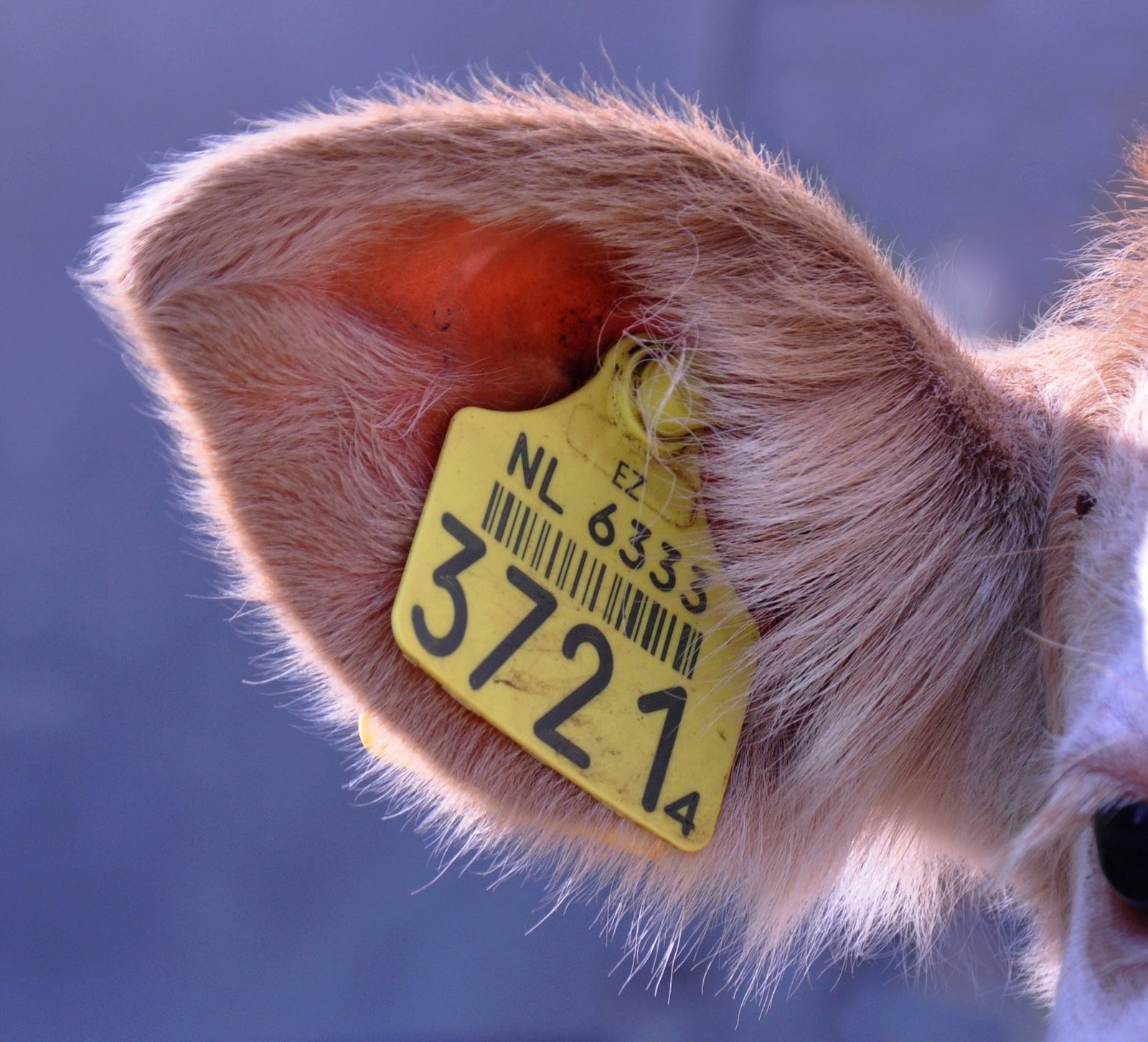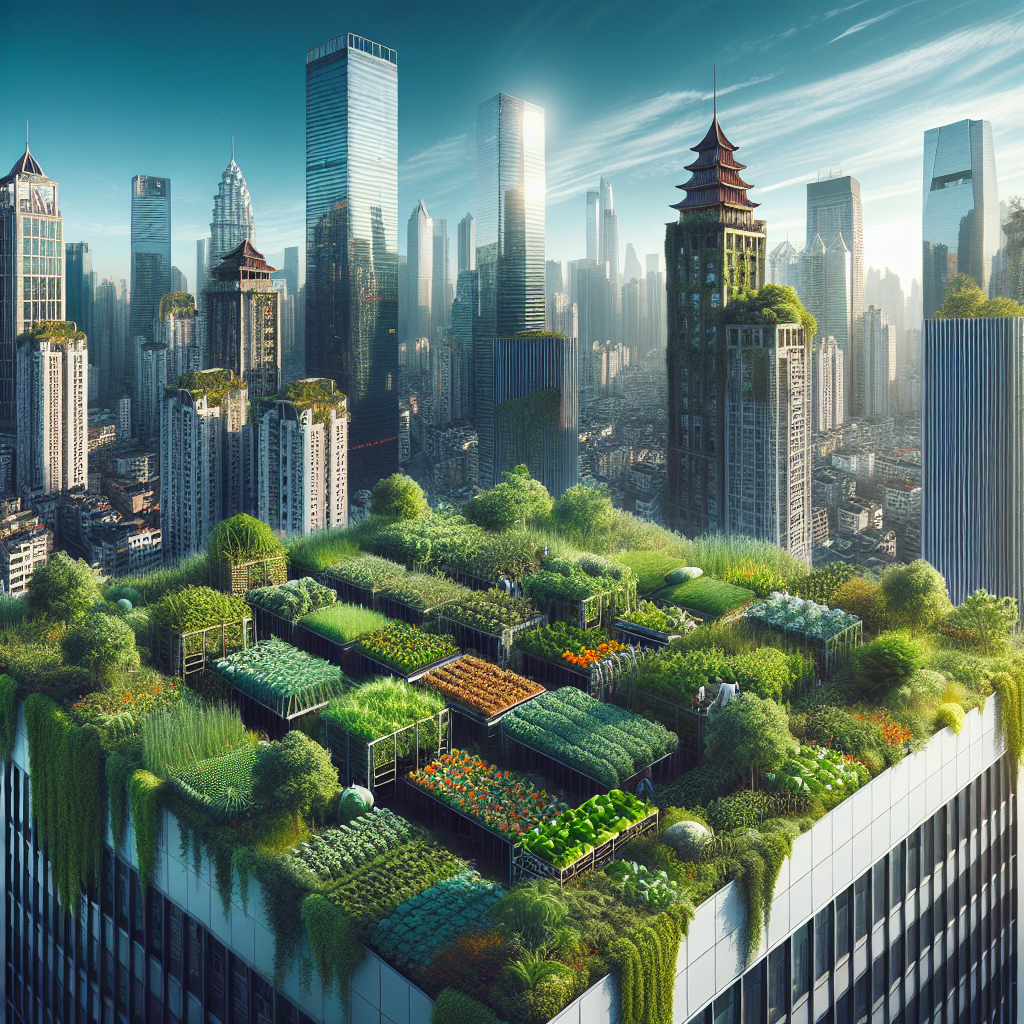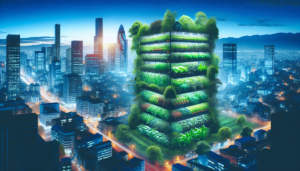
In this article, we will take a closer look at the fascinating world of urban farming and its potential impact on promoting biodiversity and enhancing urban ecology. With the growing interest in sustainable living and the need to address food security in urban areas, urban farming has emerged as a popular solution. But beyond providing fresh produce and a sense of community, could urban farming also play a crucial role in preserving and enhancing the biodiversity of our cities? Join us as we delve into this captivating topic and explore the various ways in which urban farming can contribute to the overall health and ecological balance of our urban environments.
1. Urban Farming and Biodiversity
1.1 Definition and concept of urban farming
Urban farming, also known as urban agriculture, refers to the practice of cultivating and producing food and other crops within urban areas. It involves growing plants and raising animals in the context of a city or town, utilizing different techniques and spaces such as rooftops, balconies, community gardens, and vacant lots. The concept of urban farming is rooted in the desire to establish sustainable food systems, increase food security, and promote self-sufficiency in urban environments.
1.2 Importance of biodiversity in urban ecosystems
Biodiversity, the variety of plants, animals, and microorganisms, plays a crucial role in maintaining the health and functioning of ecosystems, including urban ones. Urban ecosystems often face immense pressure due to human activities and urbanization, which can result in the loss of habitats and the decline of biodiversity. However, preserving and enhancing biodiversity within urban areas is vital for the overall well-being of communities.
1.3 Link between urban farming and biodiversity
Urban farming has the potential to contribute significantly to biodiversity conservation and restoration in urban areas. By incorporating diverse plant species, creating habitat features, and adopting sustainable farming practices, urban farming can provide crucial refuges and resources for various species. Moreover, urban farms can act as stepping stones and corridors, facilitating the movement of wildlife through fragmented urban landscapes.
1.4 Benefits of urban farming for biodiversity
Urban farming offers several benefits for biodiversity conservation. Firstly, it provides alternative habitats for native flora and fauna, providing food, shelter, and breeding sites for different species. Secondly, urban farming promotes the use of organic and sustainable farming practices, reducing the negative impacts of chemical inputs on biodiversity. Lastly, by increasing green spaces and incorporating native plant species, urban farming creates a more hospitable environment for pollinators and other beneficial insects, supporting their populations and enhancing overall biodiversity.
2. Techniques for Enhancing Biodiversity in Urban Farming
2.1 Intercropping and companion planting
Intercropping and companion planting are techniques that involve growing different plant species together in a shared space. These practices not only increase crop diversity but also enhance biodiversity by creating a more complex and varied habitat. Certain plant combinations, such as mixing flowering plants with edible crops, can attract pollinators and beneficial insects, promoting biodiversity in urban farming.
2.2 Native and pollinator-friendly plant selection
Choosing native plant species and prioritizing pollinator-friendly plants in urban farming can significantly enhance biodiversity. Native plants are well-adapted to the local environment and provide food and habitat for a wide range of native wildlife species. Pollinator-friendly plants, such as native wildflowers and flowering herbs, attract bees, butterflies, and other pollinators crucial for maintaining ecological balance.
2.3 Vertical farming and rooftop gardens
Vertical farming and rooftop gardens offer unique opportunities to expand urban farming while maximizing limited space. These techniques can contribute to biodiversity conservation by enhancing vertical habitat availability for birds, insects, and even small mammals. By integrating native plants and creating green corridors, urban farming in vertical and rooftop settings can help connect fragmented habitats within urban landscapes.
2.4 Creating habitat features
Incorporating habitat features within urban farms, such as birdhouses, bat boxes, and insect hotels, can provide additional nesting sites and shelters for wildlife. These features mimic natural habitat elements that may be lacking in urban areas and can attract a variety of species, contributing to overall biodiversity. Additionally, incorporating water features, such as bird baths or small ponds, can provide a vital resource for both fauna and flora.
2.5 Integrated pest management
Implementing integrated pest management (IPM) practices can reduce reliance on chemical pesticides and promote biodiversity in urban farming. IPM involves using a combination of techniques, such as biological control, crop rotation, and physical barriers, to manage pests effectively. By avoiding indiscriminate pesticide use, urban farmers can protect beneficial insects and other wildlife, contributing to a healthier and more diverse ecosystem.

3. Ecological Significance of Urban Farming
3.1 Urban farming as green infrastructure
Urban farming functions as a form of green infrastructure, contributing to the ecological functioning and resilience of urban ecosystems. Green infrastructure refers to the interconnected network of green spaces, including urban farms, parks, and street trees, that provide multiple ecological and societal benefits. Urban farms can mitigate urban heat island effects, improve air quality, and reduce stormwater runoff, benefitting both humans and wildlife.
3.2 Carbon sequestration and climate change mitigation
Urban farming can play a role in mitigating climate change by acting as carbon sinks. Plants absorb carbon dioxide during photosynthesis, helping to reduce greenhouse gas concentrations in the atmosphere. By promoting the growth of vegetation through urban farming, cities can contribute to carbon sequestration, thus offsetting carbon emissions and combating climate change.
3.3 Soil health and nutrient cycling
Urban farming practices, such as composting and organic fertilization, enhance soil health and nutrient cycling. Composting organic waste diverts it from landfills and transforms it into nutrient-rich soil amendments. By enriching the soil with organic matter, urban farms promote microbial activity, improve soil structure, and increase nutrient availability for plants. Healthy soils sustain diverse plant communities and contribute to overall ecosystem functioning.
3.4 Water conservation and management
Urban farming can contribute to water conservation and sustainable water management in cities. Various techniques, such as drip irrigation and rainwater harvesting, help minimize water use and reduce reliance on freshwater sources. By adopting efficient watering practices, urban farms can reduce the strain on municipal water supplies while maintaining healthy crops and supporting biodiversity.
3.5 Urban farming in food deserts
Urban farming has the potential to address food insecurity and promote access to fresh, nutritious food in underserved areas known as food deserts. By establishing community gardens and urban farms in these areas, fresh produce can be grown locally, increasing food accessibility and reducing dependence on long-distance transportation. This approach not only improves food security but also enhances community resilience and social cohesion.
4. Challenges and Limitations of Urban Farming for Biodiversity
4.1 Land availability and urban sprawl
One of the primary challenges for urban farming is limited availability of suitable land. Urbanization and urban sprawl have resulted in the loss of open spaces and agricultural lands, making it challenging to establish large-scale urban farms. As a result, urban farmers often have to adapt and maximize limited space to incorporate biodiversity-friendly practices.
4.2 Soil contamination and pollution
Urban areas often face issues related to soil contamination and pollution, which can pose risks to both human health and biodiversity. Urban farming in contaminated sites may require remediation efforts to ensure safe food production. Additionally, pollution from traffic emissions and other sources can negatively impact the quality of soil, air, and water, affecting the viability of urban farming practices.
4.3 Invasive species and exotic plants
Urban farming can unintentionally facilitate the introduction and spread of invasive species and exotic plants, which can outcompete native species and disrupt local ecosystems. It is crucial for urban farmers to carefully select plant species and monitor their farms for invasive species to prevent ecological imbalances and protect the local biodiversity.
4.4 Lack of biodiversity-oriented farming practices
While urban farming holds potential for enhancing biodiversity, the lack of awareness and implementation of biodiversity-oriented farming practices remains a limitation. Many urban farmers may prioritize crop productivity over biodiversity conservation due to economic pressures or lack of knowledge. Promoting education and training on sustainable farming techniques can help address this limitation and encourage biodiversity-friendly practices.
4.5 Human-wildlife interactions
Urban farming can increase interactions between humans and wildlife, which may pose challenges and potential conflicts. Some wildlife species, such as birds or mammals, may damage crops or cause hygiene issues. Balancing the needs of wildlife and urban farmers requires implementing appropriate measures, such as bird netting or wildlife deterrents, to protect crops while respecting the ecological role of wildlife in urban ecosystems.

5. Urban Farming Initiatives and Case Studies
5.1 Community gardens and allotment schemes
Community gardens and allotment schemes are common urban farming initiatives that bring together individuals and communities to cultivate shared spaces. These initiatives often focus on promoting biodiversity and community engagement. For example, the GreenThumb program in New York City supports over 500 community gardens, providing urban residents with opportunities to grow food, foster biodiversity, and build strong social connections.
5.2 City-wide urban farming policies
Cities around the world have embraced urban farming by implementing city-wide policies and strategies. For instance, Berlin’s “Urban Agriculture Strategy” promotes the integration of urban farming into the city’s planning, emphasizing its potential to enhance biodiversity, food security, and climate resilience. Such policies provide a framework for urban farmers to operate, ensuring the long-term sustainability and impact of urban farming initiatives.
5.3 Urban farming in vertical and indoor settings
Vertical farming and indoor agriculture have gained popularity in urban areas where space is limited. In cities like Singapore, vertical farms utilize advanced technologies, such as hydroponics and vertical stacking, to grow crops in climate-controlled environments. These innovative approaches allow year-round production and reduce the need for land-intensive agriculture while offering opportunities for enhancing biodiversity through careful plant selection and utilization of artificial habitats.
5.4 Successful urban farming projects around the world
Numerous successful urban farming projects demonstrate the positive impact of urban farming on biodiversity and urban ecology. For example, the “Detroit Hives” initiative in Detroit, Michigan, transforms vacant lots into beekeeping sites, promoting honeybee conservation and providing pollination services. Similarly, the “GuerillaGrafters” project in San Francisco grafts fruit-bearing branches onto existing ornamental city trees, adding food-producing capacity and enhancing biodiversity.
6. Urban Farming and Education
6.1 Role of urban farming in environmental education
Urban farming provides unique opportunities for environmental education, connecting people with the natural world and fostering a deeper understanding of ecological processes. By engaging in hands-on activities, such as planting, harvesting, and composting, individuals, particularly children, can learn about biodiversity, food systems, and sustainable practices. Urban farms can serve as living classrooms, promoting environmental literacy and inspiring future generations to care for the planet.
6.2 Engaging communities in urban agriculture
Engaging communities in urban agriculture can strengthen social bonds, empower individuals, and promote stewardship of local ecosystems. Community participation in urban farming fosters a sense of ownership and encourages collective action. Through workshops, volunteer programs, and skill-sharing activities, urban farming initiatives can bring diverse groups of people together, bridging social and cultural divides to create a more inclusive and resilient urban community.
6.3 Integrating urban farming into school curricula
Integrating urban farming into school curricula provides students with valuable learning experiences and encourages them to become active participants in sustainable agriculture. By incorporating urban farming into science, biology, or geography classes, students can explore topics such as biodiversity, ecosystem dynamics, and sustainable food production. This hands-on approach not only enhances academic knowledge but also promotes critical thinking and environmental stewardship.
6.4 Benefits of hands-on learning in urban farming
Hands-on learning in urban farming offers numerous benefits for individuals of all ages. It allows for experiential learning, where individuals can directly observe and engage with ecological processes. This type of learning promotes a deeper understanding and appreciation for the interconnectedness of living systems. Hands-on experiences also provide opportunities for skill development, resourcefulness, and problem-solving, fostering environmental consciousness and a sense of responsibility towards the environment.

7. Economic Considerations and Urban Farming
7.1 Urban farming as a source of income
Urban farming has the potential to generate income for individuals and communities. By selling produce, organic products, and value-added goods such as jams or sauces, urban farmers can create a revenue stream. This income-generation opportunity can enhance financial security and economic resilience for urban farmers, especially in marginalized communities where access to traditional employment may be limited.
7.2 Employment opportunities in urban agriculture
Urban agriculture can create employment opportunities, ranging from farm managers and agricultural technicians to marketing and sales positions. As urban farming continues to grow, there is a demand for skilled individuals who can manage and operate urban farms efficiently. These employment opportunities contribute to local economies, reduce unemployment rates, and enhance food security by increasing local food production and distribution.
7.3 Economic impact of urban farming on local communities
Urban farming can have positive economic impacts on local communities. By promoting local food production and consumption, urban farms reduce the dependence on imported foods, benefiting local farmers and businesses. Additionally, urban farming initiatives can attract tourists and visitors interested in sustainable agriculture, creating a niche market and generating additional revenue for local economies.
7.4 Cost-effective urban farming techniques
Implementing cost-effective urban farming techniques is essential for increasing accessibility and viability for urban farmers. Techniques such as container gardening, vertical growing systems, and soilless cultivation methods, such as hydroponics, can minimize expenses related to land use, water consumption, and inputs. Additionally, community-led initiatives and cooperative models can help share resources and decrease individual costs, further enhancing the economic viability of urban farming.
8. Policy and Planning for Urban Farming
8.1 Supportive policies for urban agriculture
Supportive policies are crucial for facilitating the growth and success of urban farming initiatives. Local governments can implement policies that prioritize and incentivize the incorporation of urban farming into land-use planning, zoning regulations, and urban development strategies. By providing clear guidelines, reducing bureaucratic barriers, and offering financial support, policymakers can create an enabling environment for urban farming to thrive and contribute to biodiversity conservation.
8.2 Integration of urban farming in urban planning
Integrating urban farming into urban planning processes ensures that it is considered from the early stages of city development. Incorporating green spaces, agricultural land-use designations, and requirements for biodiversity-friendly practices in urban planning documents can help preserve and enhance urban ecosystems. This integration also allows for the creation of well-connected green networks that support ecological connectivity and the movement of wildlife.
8.3 Zoning and land use regulations
Zoning and land use regulations play a crucial role in determining where and how urban farming can take place. Designating appropriate zones for urban agriculture and updating regulations to accommodate diverse farming practices can provide legal clarity and minimize potential conflicts with other land uses. It is important for zoning regulations to consider the specific needs of urban farming, allowing for flexibility and adaptation to changing urban landscapes.
8.4 Incentives for promoting urban farming
To encourage urban farming and address the challenges associated with it, governments can offer various incentives to urban farmers and landowners. These incentives may include tax breaks, grants, low-cost land leasing, or even access to shared resources and infrastructure. By providing incentives, policymakers can support the expansion of urban farming, promote biodiversity, and achieve broader environmental and societal goals.

9. Synergies between Urban Farming and Wildlife Conservation
9.1 Enhancing urban wildlife habitats
Urban farming has the potential to enhance wildlife habitats within cities by providing diverse and resource-rich environments. By incorporating native plants, water features, and habitat structures, urban farmers can create favorable conditions for wildlife, including birds, bees, butterflies, and even small mammals. These enhanced habitats support biodiversity, contribute to urban ecological networks, and promote the presence of wildlife in urban areas.
9.2 Promoting wildlife corridors and connections
Urban farming can play a vital role in promoting the creation of wildlife corridors and connections in fragmented urban landscapes. By strategically locating urban farms and maintaining green spaces, urban planners and farmers can facilitate the movement of wildlife between different habitats. These connections allow for genetic diversity, species dispersal, and adaptation to changing environmental conditions, promoting long-term wildlife conservation.
9.3 Preservation of native plant species
Integrating native plant species into urban farming practices can contribute to the preservation of these plants within urban areas. Native plants provide food and habitat for native wildlife species, fostering ecological balance and enhancing biodiversity. By selecting and cultivating native plant species, urban farmers actively participate in the preservation of regional and local plant diversity while supporting wildlife conservation efforts.
9.4 Monitoring and documenting urban biodiversity
Monitoring and documenting urban biodiversity are essential for understanding the impacts of urban farming and implementing effective conservation strategies. Engaging citizens, researchers, and urban farmers in citizen science initiatives can contribute to the collection of valuable data on species distribution, abundance, and ecological interactions. This information can guide urban planning and management decisions, promoting evidence-based actions that enhance biodiversity in urban farming.
10. Future Prospects and Conclusion
10.1 Advancements in urban farming technologies
Advancements in technology hold promise for the future of urban farming and its impact on biodiversity. Innovations such as vertical farming systems, hydroponics, and aquaponics are improving resource efficiency, increasing crop yields, and expanding the potential for urban agriculture. These technologies allow for precise control of growing conditions, reduce water and land use, and provide opportunities for year-round production, ensuring sustainable and biodiverse urban food systems.
10.2 Scaling up urban farming for greater impact
Scaling up urban farming initiatives can significantly enhance their impact on biodiversity and urban ecology. As cities continue to grow, there is a need to integrate urban farming into broader urban development strategies and policies. By establishing networks of interconnected urban farms and promoting commercial-scale urban agriculture, cities can create a resilient and diverse urban food system that supports both human well-being and biodiversity conservation.
10.3 Collaborations between researchers and practitioners
Collaboration between researchers, practitioners, and policymakers is crucial for advancing urban farming practices that promote biodiversity. By fostering interdisciplinary partnerships, scientific knowledge can be translated into practical implementation strategies. Researchers can work with urban farmers to explore biodiversity-friendly farming practices and evaluate their ecological effectiveness. These collaborations ensure that urban farming contributes to biodiversity conservation while meeting the needs of urban communities.
10.4 Summary of benefits and challenges
Urban farming offers numerous benefits for enhancing biodiversity and urban ecology. It provides alternative habitats, promotes sustainable farming practices, and supports pollinators and other wildlife species. However, challenges such as limited land availability, soil contamination, and invasive species need to be addressed to maximize the benefits of urban farming for biodiversity conservation. Through careful planning, education, and collaboration, these challenges can be overcome, paving the way for sustainable urban farming systems.
10.5 Conclusion
Urban farming plays a vital role in enhancing biodiversity and urban ecology. By incorporating diverse plant species, utilizing innovative techniques, and adopting sustainable farming practices, urban farmers can create habitat features, support native wildlife, and contribute to the preservation of urban biodiversity. Additionally, urban farming provides educational opportunities, fosters community engagement, and offers economic benefits for individuals and local communities. By recognizing and addressing the challenges associated with urban farming, policymakers, researchers, and practitioners can maximize its potential for biodiversity conservation, resilience, and sustainability in urban environments.








